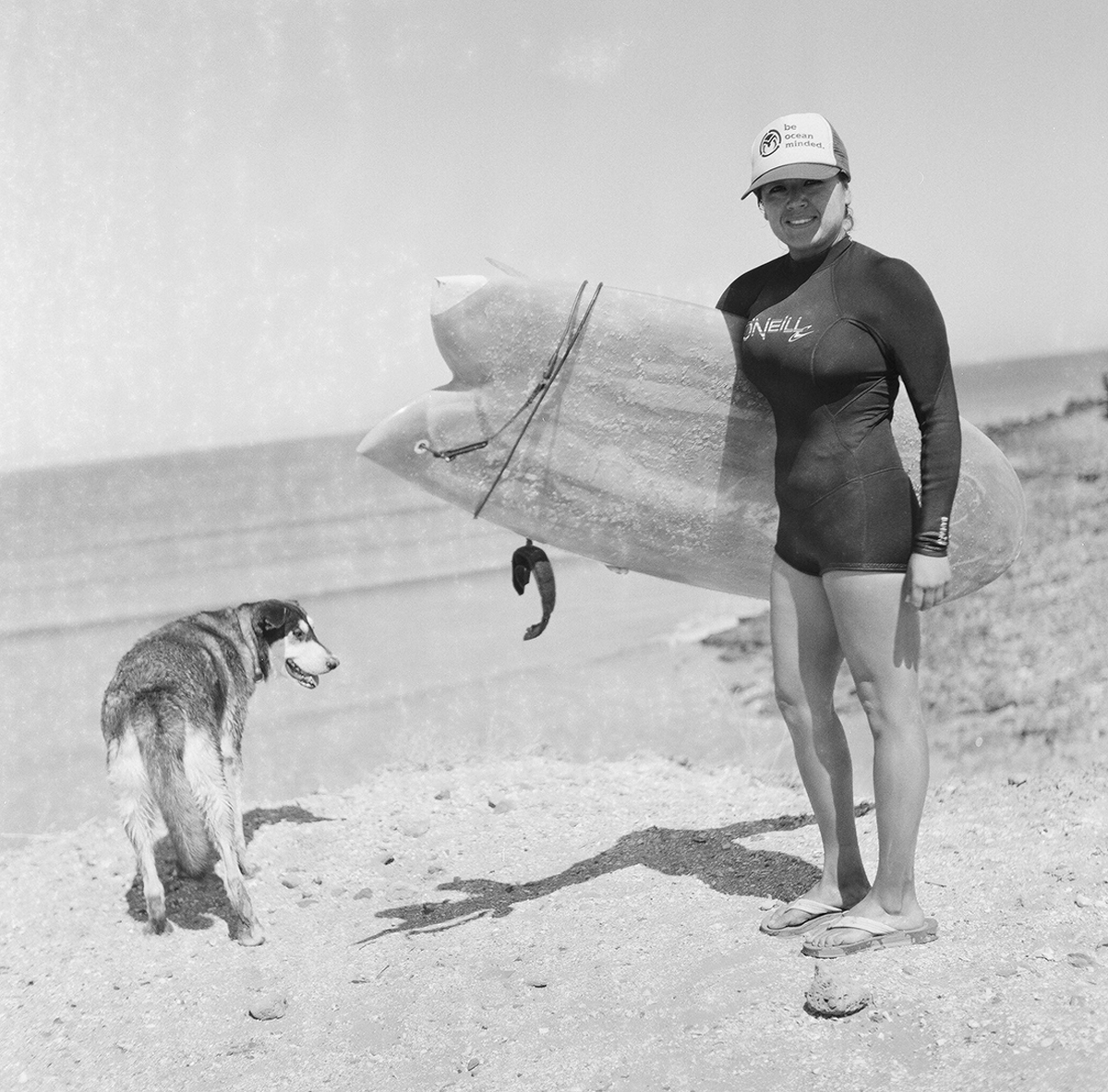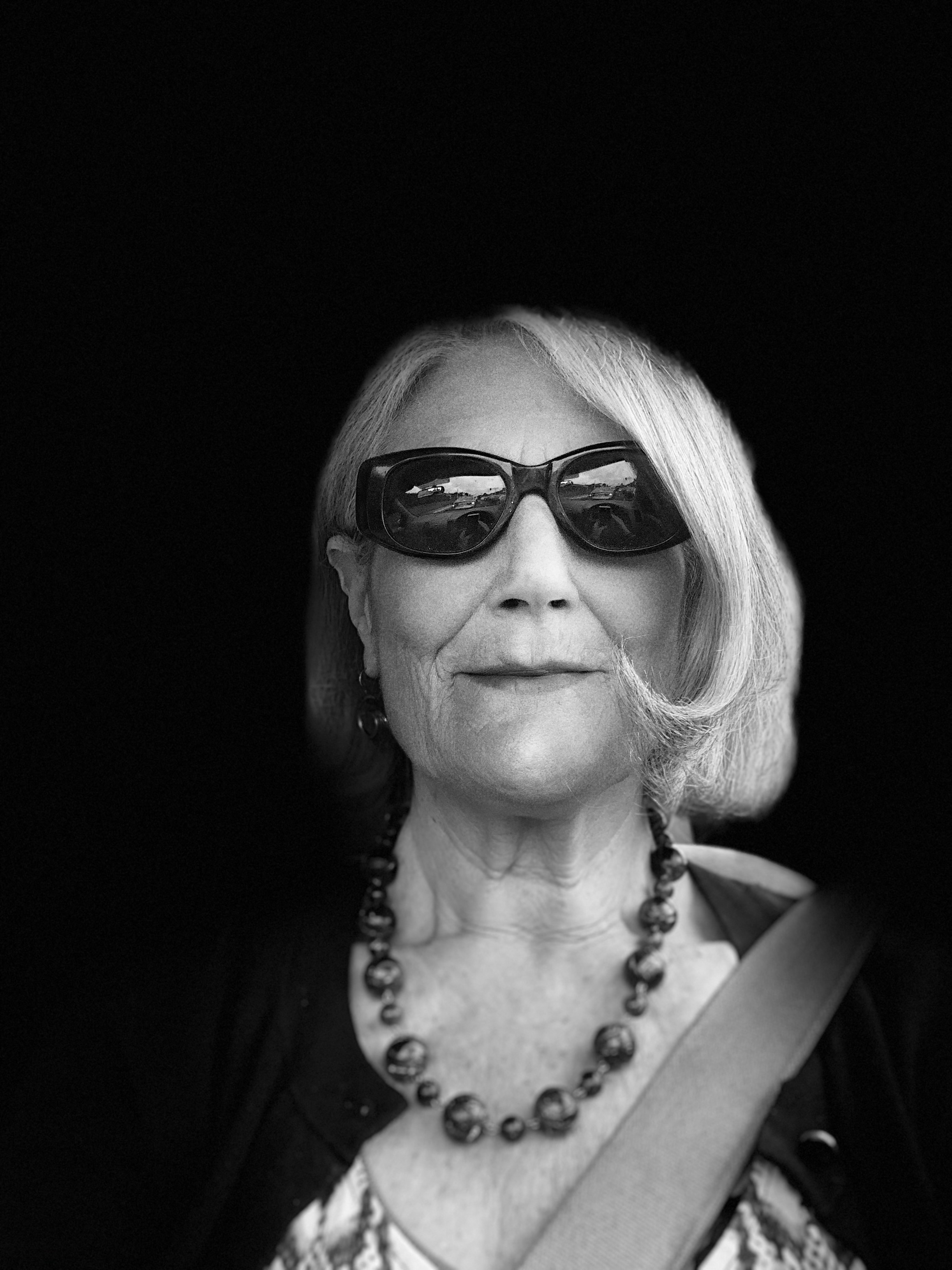
The San Onofre Parks Foundation (SOPF) held the final event in its summer speaker series, titled “Surfing Beyond the California Beach Babe Cliché,” with a talk and film screening on Sept. 19. The timing was auspicious, though unplanned: The World Surf League had just announced equal prize money would be awarded for men’s and women’s contests; the next day would be California’s inaugural Surfing Day; and it was the birthday of Mayra Aguilar, the subject of the night’s documentary, La Maestra (The Teacher).
What is happening in surfing beyond the beach-babe trope? A ton, as it turns out. Are mainstream action-sports companies still using teen models in bikinis or surf suits with “cheeky coverage” posing near surfboards to sell their wares? Sure, they are. But as Rice University professor Krista Comer said at the beginning of her lecture, lots of people have been living beyond the clichés for a long time.
Joining the professor to screen La Maestra was one such stereotype-buster, photographer and filmmaker Elizabeth Pepin Silva. Her punk roots go back to getting the Dead Kennedys to play her sister’s high school in San Francisco, where Silva later had a record store, worked at the Filmore—part of her job was telling people that just because they’d once smoked a joint with Jerry Garcia, they couldn’t get in free—and eventually landed a gig at PBS station KQED, where she acquired the chops to make her own docs.
“I started surfing in 1985 and began taking surf photos in 1995,” says Silva, who met Comer not long after. She’d come out of the water, then start taking pictures of her fellow surfers from the lineup. “I came at it originally to offer up an alternative visual perspective of women surfers than what [was pervasive] in surf media and advertising—when the surf media and ads bothered to show women at all.” The multi-Emmy-winner has made cinematic portraits of Sarah Gerhardt, the first woman to surf Maverick’s, and the upcoming Super Stoked Surf Mamas of Pleasure Point.
Comer, who grew up in Southern California, heard some big claims in the 1990s that just didn’t seem viable: Surfing had become “green,” progressive and girl-friendly. So she launched an investigation, seeking out women surfers to get the firsthand scoop. The result of her 10-year research is the book Surfer Girls In the New World Order, featuring a cover photo by Silva.

At dusk, when everyone—including the San Clemente High School girls surf team—had gathered on the large patio of the 1934 ranger cottage that serves as SOPF’s visitor center, Comer shared a glimpse into her discoveries: There are Muslim women who surf in Bali and Gaza, and organizations that defy the blond-and-blue-eyed surfer-chick image that clings tightest in Southern California, such as Black Surfers Alliance, Brown Girl Surf and Project Wahine.
A touchstone throughout her research was the Paradise Surf Shop in Santa Cruz, where the presenters first crossed paths. The shop not only carries gear for women of all shapes and sizes, but it also provides a hangout that disseminates information on breast cancer and functions as a rape-crisis center, all while organizing surf contests and community events.
Academically, the book is a case study on globalization, bringing a critical eye to surfing’s impact for good and ill, but it also focuses on artists whose work attacks clichés, including It Ain’t Pretty, a film by Dayla Soul about women charging tow-in-sized waves, and surf camps for women, such as Las Olas in Sayulita, Mexico, that teach ecology and local culture before anyone learns to pop up on a board.
After Surfer Girls was released in 2010, Comer was astonished that women surfers actually read it, long before any of her academic colleagues did. Their overwhelming response led to the Institute for Women Surfers, whose mission is the sharing of knowledge across generations and approaches in a space where artists, practitioners and academics can become better collaborators and activists. On the steering committee is Silva and San Clemente’s Dina Gilio-Whitaker (Colville Confederated Tribes), who did some myth-busting of her own in a talk on “Native Americans and Surf Culture” earlier in the summer.
An altogether different kind of teacher is the subject of La Maestra. “Trailblazer” seems too forceful a word for the gentle Aguilar, but she was the first woman to surf the remote break in southern Baja where she was born and now teaches school. The lineup for her is indeed girl-friendly; the only aggression she reports on her paradise of waves is between Americans.
The 30-minute film unfolds leisurely, matching the pace of life in the isolated fishing village where electricity is spotty and there’s no mail service. In each shot, it’s clear how the entire Aguilar family welcomed Silva and her collaborator Paul Ferraris into their world. The camera is forgotten as we watch Mayra prepare for the day or embrace each parent before heading off to surf.
While Aguilar patiently interacts with her students, she describes in voice-over the challenge of having kids at varying levels in one class, just as teachers here do. In contrast, teachers in a small village are regarded with respect, she explains, and approached for help in solving life’s problems. She is the first in her family to graduate from college, an education affordable because of income generated by surfing tourists.
Aguilar’s presence on a wave is captivating. She approaches the nose as if doing tai chi; she lifts a foot high and appears to fly, then steps down softly and in complete awareness of the water below her board. The rides are lengthy. The camera floats as Aguilar cuts through the water toward the lens, or it moves closely behind her at speed, or frames wave and rider in a long shot from shore over her dog’s shoulder.
Though Silva had reminded everyone before La Maestra rolled that it wasn’t a typical surf film, one old guy marred the screening by “whispering” loudly throughout. In the Q&A, he belted out the first question in his normal speaking voice, “So, where was this?” When Silva answered, she would only divulge that if you “drive south for two days, you’re going to find it.”
“Ah, been there, done that,” he bellowed. The jolly but out-of-touch dude was long gone by the time the discussion turned toward ways to, as one audience member put it, “be a good guest” wherever you travel.
As the smell of campfire smoke wafted into our noses, for most of us, the evening proved that surfing has the potential to become ever more green, progressive and girl-friendly.
For more information on Silva, visit otwfront.net. Check out the Institute for Women Surfers at www.instituteforwomensurfers.org and the San Onofre Parks Foundation at www.sanonofreparksfoundation.org.

Lisa Black proofreads the dead-tree edition of the Weekly, and writes culture stories for her column Paint It Black.

